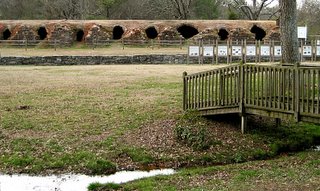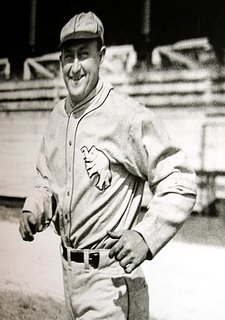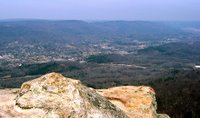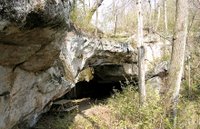 Fort Oglethorpe & the Sixth Cavalry Museum
Fort Oglethorpe & the Sixth Cavalry MuseumWe stopped by the 6th Calvary Museum, it is a small two story building filled with displays and exhibits, which include photos, maps, uniforms and much more, most of which were donated by members of the 6th, who hold their reunion here every year. Not only do you learn the history of the 6th Cavalry, which has served on the Texas border during the Indian Wars, the Spanish-American War, and the Boxer Rebellion, in pursuit of Poncho Villa and is currently stationed in Korea. They also tell you how to float a jeep across a stream or small river if you ever need to, also on display is a Patton Tank & a Cobra Gunship.

The curator was a really nice lady and gave me the keys to the Patton Tank, really, not to drive but to open the top hatch so I could climb inside. I climb up top and looked inside the turret and decided I was a little too old and round to try and squeeze through the hatch. The museum is of the grounds of the old Fort Oglethorpe, which is now the city of Fort Oglethorpe; several post buildings have been converted to new uses. The gymnasium is now a restaurant and antique shop, the PX is now an antique store, one stable houses a gift shop, one of the officers’ houses is a bed-and-breakfast and the rest private residence. At the entrance to the parade grounds, the Post Chapel and the Post Theater are still in use. The original flagpole and the original post bandstand can also be seen. The fort held German POWs during both WWI & WWII, over 180 of them died while being prisoners here and are buried at the Chattanooga Nation Cemetery, which we are going to next.
Chattanooga National Cemetery
This is one of the oldest and largest Nation Cemeteries in the country, started in 1863 to bury the Union soldiers killed during the battles of Chickamauga, Chattanooga, Lookout Mountain and Missionary Ridge. At the office we picked up a Self-guided Historical tour pamphlet that an Eagle Scout made up to honor his grandfather who is buried here, it sure made finding things much easier. Like everything around here, it’s hilly, we parked at the Circle of Honor where there are about 20 memorials covering everything military from the civil war to the woman of WWII to Vietnam. This is on the highest ground so when were done playing mountain goat we still had the worst climb to get back to the car. We spent about three hours here (a lot of that time was catching our breath) there are so many interesting and unusual things to see, a Memorial archway that was built in 1868 is one of five built in the National Cemeteries, they are 40 feet tall and are modeled after the triumphal arches of ancient Rome.

A monument erected by the German Government in 1935 to honor the 78 prisoner who died during WWI, another 105 German POWs died here in WWII. As far as I could find out this is the only National Cemetery with Foreign POWs buried in it. We also found the Fourth Army Corps Obelisk monument, the Armed Forces Pavilion, the two limestone caves (closed in 1930s when two explorer died in them) and four of the Six Medal of Honor Recipients that are buried here.

Also the Andrews Raiders Monument, otherwise known as “The Great Chase”. James Andrews along with Union troops from Ohio in an attempt to destroy Railroad bridges and the telegraph lines stole the train known as the “General” they went on a 90 mile chase being pursued by the Confederate soldiers, when the train ran out of fuel they continued on foot until they were all captured a few weeks later (Disney made a movie about this). Eight of the raiders including Anderson (a Civilian) were executed. Their actions are what inspired the US Government to come up with a special medal to honor this type of courage, “The Medal of Honor”. They were the first to receive the medal.
Chattanooga Zoo
Time for a Freebee the Chattanooga zoo, this one is on the small side, they house about 21 different exhibits and a petting ranch for the kids. This is very well run zoo with very nice exhibits, better then some of the really big zoos that we’ve been to. It’s almost impossible to find since it’s hidden behind a baseball stadium in Wagner Park, you just keep driving through parking lots until you see the signs and there you are. Our absolute favorite was the albino anaconda, a mixture of snow white and sunshine yellow, we could have watched it for hours. This place is hidden so well that they looked shocked when you walk through the door; there were probably only 20 people in the zoo while we were there.
Old Coke Ovens of Chickamauga
This is another reason to just stumbled around on back roads; we came across these
100-year-old coke ovens just outside the town of Chickamauga. The Durham Coal Company used these ovens to convert coal into coke, which was then shipped by train to be used in the foundries of Chattanooga (we’ll hiked this old railroad bed a little later). The coke ovens were in operation until the Depression when they ran out of coal. The ovens were restored in the 1990’s and a few railroad coal cars were put on display. There are about 50 beehive style ovens here with plaques explaining their history and how they operated, a small pond with a footbridge and picnic tables with grills. It always amazes us at what you can find on the little back roads. Then it was into town were Cathy spotted a great little southern cooking style restaurant “The Melon Patch” great food and plenty of it.
Lula lake Land Trust
Here is were the railroad bed comes into our visit, the old railroad bed runs right through this land trust and is now the main trail that takes you to Lula Lake and Falls. This place is run by volunteers and is only open to the public on the first or last Saturday of the month between 9am – 5pm. We got our map from the guide and immediately folded it up and put it in our pocket because who needs maps. There are about ten miles of marked trails so we choice was the easy one that takes you to Lula Lake and then Lula Falls, it follows the old railroad bed all the way their and back. It took us right along the side of the creek for about a mile until then we came to the new footbridge, (the old one was washed out during a storm) from there we could see the lake and the top part of the first falls.

On a little further and we found a little picnic area with a fantastic view of the lake and smaller falls, Cathy found a small path made for stones that she insisted that I take you down to the lakes edge. The water is crystal clear in the creek; the lake due to its depth (65ft) is a beautiful emerald green. Another quarter of a mile and were at the big falls, Lula Falls, I would guess that they are about 80 to 100 feet tall. Again Cathy spotted a trail that leads down to the base of the falls, this is a very steep, muddy and slippery, Cathy decided to stay at the top, she said it would be easier for her to dial 911 from there. I wanted to get some pictures so down I went. I made it to the bottom with three slips and no falls, after taking a few pictures I saw that you could walk around behind the falls to a small cave like opening, hey as long as I’m down here. Right then wind decided to change a little so I ended up getting pretty wet from all the mist (really it was the mist, I didn’t fall in). I chalked up another five or six slips with one where I buried my hand in the mud to keep from having a muddy bottom.

When climbing out it was like climb ten steps and stop to caught my breath, repeat, repeat, repeat until I got to the top (probably 15 minutes but it felt like an hour). Twenty minutes of sitting to catch my breath with Cathy’s fingers poised over the buttons 911, I was ready to move on. It took about two hours to get rid of the rubbery legs, which we spent most of it in a little café on top of Lookout Mountain.
A little side trip to Cleveland
We spent one day doing a little side trip over to the City of Cleveland, no not the one on the lake. Our first stop was to see one of the “Whispering Giants” that was carved by Peter Toth to honor the Indians that were on the “Trail of Tears” which started near here at Red Clay.
Only a few blocks away is the Bloody Mausoleum made famous by “Ripley’s Believe it or Not”, so off we go in search of blood. As the story goes Little Nina was out for a buggy ride with her Grandfather, he had done this many times before, and Nina absolutely loved riding. Apparently, Dr. Thompson lost control of the horse and buggy, because it went directly into the path of a train. Dr. Thompson was thrown to safety, but Nina was killed. Mr. Craigmiles (Nina’s father) had a mausoleum built behind the church in memory of his daughter. She was laid to rest inside, as was another infant son who died, and Mr. and Mrs. Craigmiles. Mr. Craigmiles met an untimely death after falling on some ice, which apparently triggered blood poisoning. A third member of the family had met a tragic death.

If you visit the mausoleum, you will notice red streaks the color of blood appear on it. The stories say that the bloody stains first began to appear on the Craigmiles mausoleum after Nina was interred there. With the death of each family member, the stains grew darker and more noticeable. Some of the locals began to believe that the marks were blood, coming from the stone itself, in response to the tragedies suffered by the family. They have washed and scrub the stains with bleach and even replaced some of the marble but the bloody stains always reappear.
Red Clay Historical Park
Take a few roads until you think that you’re lost and you’ll find the Red Clay Historical Park, this was the Cherokee Council Grounds from 1832-1838. They moved here from Echota Ga. when the State of Georgia stripped them of all the rights to sovereignty. After a few years here the U.S.A. decided that they wanted the land and that was the start of the Trail of Tears to their relocation out west. This is a nice little park with a visitor’s center, Blue Spring and Mill Creek, a recreated village and the Eternal Flame of the Cherokee.
Nancy Ward
Make a few more wrong turns, look up on a hill and say what the hell is that and you’ll find the grave of Nancy Ward. This is her story according to the plaque that was there. Nancy was called upon to show the depth and strength of her character as a young bride while assisting her husband during a battle against the Creeks. When he was shot and killed, Nancy picked up his gun and continued the battle, rallying the Cherokee to victory. The Cherokee paid homage to Nancy and made her a Beloved Woman, a
position reserved for brave and wise women who have served the people well.
As a Beloved Woman, Nancy had full voice and full vote in all tribal councils, held the power of life and death and, with the other Beloved Women of the Council, was the final arbitrator of any and all disputes and decisions affecting the Cherokee. Her first official act as a Beloved Woman was to save the life of a white woman condemned to die.
Nancy was a devout believer in peaceful co-existence with the whites. She earned the respect of both the white government and her own people by her successful negotiations and mediations. Moravians who had been allowed to settle in the area had educated her, and she served as interpreter when the need arose. Nancy constantly traveled the territory diverting conflict between the European settlers and her people, and was the driving force behind many peace agreements - she was a true politician.
Nancy was instrumental in negotiating the very first treaty between the white government and the Cherokee, known as the Treaty of Hopewell, and was present at its signing. During the years, Nancy watched her work being destroyed as treaty after treaty was broken, and she became increasingly suspicious of the white government.
She began to speak out against the continuing sale of Cherokee lands to the whites, but her fears were not taken seriously. She moved into Tennessee where she operated a successful inn until her death.
Nancy Ward is highly regarded by the Cherokee Nation, and many honors have been bestowed in her name. A Tennessee chapter of the Daughters of the American Revolution is even named for her.
Here endth the lesson.




















